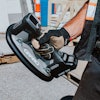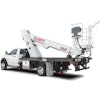
Gearflow sat with Josh Nickell to learn what enabled Nickell Rental to be acquired for a historical multiple in 2018 by Sunbelt Rentals
In the equipment rental industry, many businesses are renting out the same equipment as you are. Therefore, it is imperative for rental business owners to think differently. But for Josh Nickell, the third-generation ex-CEO of Nickell Rental, it’s clear he did things differently.
During his tenure as CEO from 2012-2018, Nickell Rental achieved:
- 20% compound annual growth for five straight years
- 90%+ employee retention rate across its 80-person team
- $2 million EBITDA on a $7 million topline at the time of its acquisition by Sunbelt Rental for a historic multiple in 2018
These metrics are the result of the many incremental improvements Nickell had implemented over the years that ultimately led to an acquisition offer from Sunbelt that the company could not refuse.
Here’s a look at how Nickell Rental approached growth differently, the incremental improvements Josh Nickell made and how he worked to implement them during his time as CEO.
1. Start with Employee Engagement
Nickell is a big believer in investing in employee engagement.
“We had a commitment from all of our employees that they would have to say what they were great at and passionate about every day,” he notes. “This was tracked and used in quarterly reviews and branch reviews. This helped us easily identify people’s strengths and align their strengths to work they could run with.
For example, Nickell Rental had consistent call tracking with each employee. “Every two weeks we would go over a recorded call of a live interaction with a prospect and use the call to coach the employee,” Nickell explains.
“Typically people are nervous about call tracking, but if you have someone that is excited about what they do, then they will want that type of coaching,” he continues. “The training is then just helping them go in the direction they already wanted to go.”
2. Measure What Matters
A lot is made of tracking your financial metrics to gauge the financial health of your equipment rental business, but not a lot is made of measuring the health of your culture.
"For employee engagement and customer service, we can’t do anything with the question ‘are they organized?’ We put a system in place to quantify our employee engagement and customer service in a way that was measurable and actionable,” says Nickell.
The ADP StandOut platform that he put in place as the foundation behind his employee engagement tracking delivers eight questions with answers on a scale of 1-5 that repeats across branches and across departments.
“This system gave us actionable insights. For example, one of the questions was ‘I know what is expected of me.’ If that was our lowest scoring item then we knew we needed better job descriptions and reviews in place,” Nickell comments. “Another question was ‘my teammates have my back.’ If this was low, we knew we needed more team bonding outings. These were the most important data points for our company.
“Too many people work off of gut reactions. And a lot of times it works. However, when you are scaling a business beyond a small team, you need measurable, actionable, and replicable metrics to inform your decisions,” he emphasizes.
For example, he notes that a lot of people make equipment buying decisions by looking out at their lot. “That can work for a while, but if you want something scalable and replicable, you need to use data to put a process behind your decisions,” he advises. “Otherwise, our eight locations would be acting like eight different companies and we cannot succeed that way.”
3. Embrace Technology
Nickell used several examples of how technology was implemented into Nickell Rental’s operations. What he pointed to the most was the use of the StandOut product and the data visualization tools he used to benchmark performance.
“It’s one thing to gather the data, it’s a whole other challenge to get insights from the data,” he says. “For instance, your business being up 5% year-over-year means nothing in a vacuum. If your competitors are up 30%, you’re failing. If you’re in a recession and your competitors have flat growth, you are doing well.
This is true for all the metrics you are measuring. Nickell says the data won’t tell a full story if you have nothing to compare it to.
“The companies taking advantage of data, visualization and intelligence are using these tools to go faster,” he points out.
4. Learn From Those Who Think Differently
When it came to doing things differently, Nickell Rental wasn’t afraid to borrow from other industries.
“For instance, Apple is really good at brand experience. Amazon is really good at fulfillment. There is no need to invent, just to replicate,” says Nickell.
Nickell offered a few examples:
Social Media: “The simplest example of taking inspiration from others is how we approached social media,” says Nickell. “We looked at the event rental industry where social is incredibly important and talked to them about what had the greatest ROI. We wound up hiring a firm to manage our social media for us based on recommendations from owners in party rental.”
Website: “Another example is how we looked at our website. A lot of rental companies will say that they don’t need a great looking website because rental customers don’t come through the web,” says Nickell. However, it quickly dawned on him that all of the top retail companies in the country have the top sites in their respective categories. “Our goal was to create a modern web experience that built trust with new customers.”
Customers are quick to judge a business based on their representation online. “What we did not want is for customers to visit our website and question whether they want to do business with us,” says Nickells. “Instead, when people came across our website they would not go elsewhere because they trusted that we are professionals. We know we are competing for people’s mindshare."
Customer Service: Nickell looks to the Disney model when it comes to customer service. Disney refers to its employees as cast members. “So, we would use words like partner instead of customer, consultant instead of salesperson, etc.,” he notes.
He also noted that cast members in a Disney store are trained to greet customers within 30 seconds. Nickell and a friend even went to one of the stores to put this to the test and found it to be true. "It was an eye-opening experience for me,” he says.
“In rental, we have so many people working in and around the store. We have drivers, mechanics, management, etc. Most of the time, a customer could walk through the lot and a driver or mechanic could walk by the customer without saying anything since it’s not their job,” Nickell comments. "However, a customer doesn’t know that. All they see are employees walking by them and ignoring them.
“At Nickell, we made every employee ask the customer if someone was helping them so the customer never felt uncared for,” he says. “Three to four people were checking on the customers constantly. This made customers feel like they were cared for.”
5. Commit To Incremental Improvements
Most rental companies will admit that they have a long list of items to improve upon. But the longer the list of improvements, the larger the barrier to start implementing changes becomes. This can become a vicious cycle.
The challenge is knowing where to start. “It is very easy to pick too many changes at once,” says Nickell. “Pick two to three things a year and make commitments to see those things all the way through before moving on to the next. Give each change a fair shot. Make it habitual across the company before moving on.
“Don’t worry about whether you can achieve a drastic rate of change. Just try and make your business 1% better every day,” he continues. “Even if the change is 80% of the way there, it is progress. It doesn’t have to be perfect. Perfection is expensive and time consuming. Slightly better just takes a little effort.”
6. Find A Champion
Creating a prioritized list of improvements is the easy part. Implementation is what’s difficult. Moving from the idea phase to implementation requires finding a “champion” for that program.
“You cannot do it all. If the implementation is built around you then it either won’t scale or will fail,” Nickell states. “You as a business owner or manager need to be able to leave for a month or two and things should still work. If someone could implement something at least 80% as well as I thought I could on my own, then that person was leading the project.
“I had to remove myself from implementation. Otherwise, I would have been the bottleneck that throttled growth,” he adds.
7. Best Practices, Not Policies
Nickell made it clear that Nickell Rental did not follow a strict set of policies. “We didn’t like policies,” he says. “We instead had a growing list of best practices that we constantly iterated off of.”
Rather the company encouraged its employees to make mistakes. “We want people making mistakes. We had an employee who had a quarterly goal to make a mistake that cost over $250. This way, she was empowered to implement new strategies without worrying about making mistakes,” Nickell says.
“You need your top people rolling with implementation,” he comments. “I made sure that no one had to come back to me to check and report on things. Policies like this halts momentum.”




















